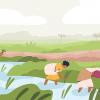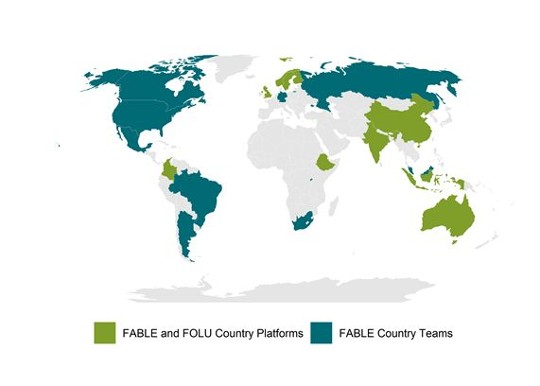
The findings of a new report by the Food, Agriculture, Biodiversity, Land-Use, and Energy (FABLE) Consortium, suggest that integrated strategies across food production, biodiversity, climate, and diets can meet the objectives of the Paris Agreement and the Sustainable Development Goals (SDGs).
The second global report of the FABLE Consortium titled, Pathways to Sustainable Land-Use and Food Systems, presents pathways towards sustainable land use and food systems for 20 countries.
The FABLE pathways set out in the report present at least one Current Trends Pathway and one Sustainable Pathway to assess how far and how quickly improved policies can make land use and food systems sustainable. The pathways have also been expanded to cover freshwater, future climate-change impacts on crops, a richer discussion of biodiversity targets, and a more detailed trade analysis. They show how countries can meet mid-century objectives on food security, healthy diets, greenhouse gas emissions, biodiversity, forest conservation, and freshwater use. Using the Scenathon methodology and linker tool developed at IIASA, the team were also able to consistently align the pathways of FABLE countries globally.
“The Scenathon methodology and the linker tool we developed ensures a truly bottom-up approach. This is one of the novelties of the project and something that we believe could be of great value to many of the participating IIASA member countries,” notes IIASA researcher Valeria Javalera Rincón, who was closely involved in the development of the Scenathon methodology and the linker tool.
The FABLE pathways can be a method for problem solving, working backwards from mid-century targets and shedding light on the major transformations that are needed to achieve them. They provide a framework for engaging stakeholders, can help identify mid-term technology benchmarks, and provide a long-term perspective to help countries avoid locking themselves into unsustainable food and land use systems. They also provide a tool for countries to integrate biodiversity conservation and restoration, as well as food systems into their climate strategies, particularly in the run-up to the climate and biodiversity Conference of the Parties (COP) in 2021.
“An integral part of the consortium’s focus is on strengthening the analytical capacities of countries to carry out integrated assessments while emphasizing collaborative approaches across scales. We have a long-term approach to explore the implications of strategic decisions in order to define the solution space for sustainable development pathways that realize national development aspirations while accounting for globally agreed targets,” comments Katya Perez Guzman, an IIASA researcher and member of the FABLE Consortium.
In just a short period, the global FABLE Consortium country teams have developed major analytical capacities on land use and food systems, pioneered new tools, and strengthened the analytical capacity in 20 countries. It plans to focus upcoming work on the following priorities:
- As part of FOLU, the consortium will work with interested governments to support integrated strategies, including climate and biodiversity strategies under the climate and biodiversity conventions that address short-term pressures on land use and food systems, and are consistent with meeting long-term goals.
- Advance a deeper understanding of how countries can design, implement, and monitor better policies to transform their land use and food systems through the new Food, Environment, Land, and Development (FELD) Action Tracker.
- Improve modeling tools to develop pathways and model policy options for land use and food systems.
- Train the next generation of analysts and policymakers in developing long-term pathways towards sustainable land use and food systems so that FABLE tools can be applied by any research group or government that would like to do so.
- Strengthen and expand the FABLE Consortium, including by welcoming new country teams.
“In 2020, the world has experienced unprecedented environmental, social, and economic crises, underscoring just how unsustainable current land use and food systems are. At the same time, we are heading towards a “super year” for sustainable land use and food systems in 2021, and there have been encouraging policy commitments from major economies. However, most countries do not have integrated policies and long-term strategies for sustainable land use and food systems. We believe the second global report of the FABLE Consortium enters this context as a very timely and relevant collective voice and method proposition,” concludes consortium member Michael Obersteiner, an IIASA researcher and Director of the Environmental Change Institute at Oxford University.
FABLE is a collaborative initiative operating as part of the Food and Land Use Coalition (FOLU). The consortium’s activities are coordinated by the FABLE Secretariat, which is led by IIASA and the Sustainable Development Solutions Network (SDSN) with support from EAT and the Potsdam Institute for Climate Impact Research (PIK).
Adapted from a press release prepared by SDSN.
 © IIASA
© IIASA
Countries represented in the FABLE Consortium and the Food and Land Use Coalition
Reference:
FABLE (2020). Pathways to Sustainable Land-Use and Food Systems. 2020 Report of the FABLE Consortium. International Institute for Applied Systems Analysis (IIASA) and Sustainable Development Solutions Network (SDSN), Laxenburg and Paris [pure.iiasa.ac.at/16896]
News

22 July 2024
Are sustainable aviation fuels truly sustainable?

17 July 2024
Forests endure as carbon sink despite regional pressures

16 July 2024

